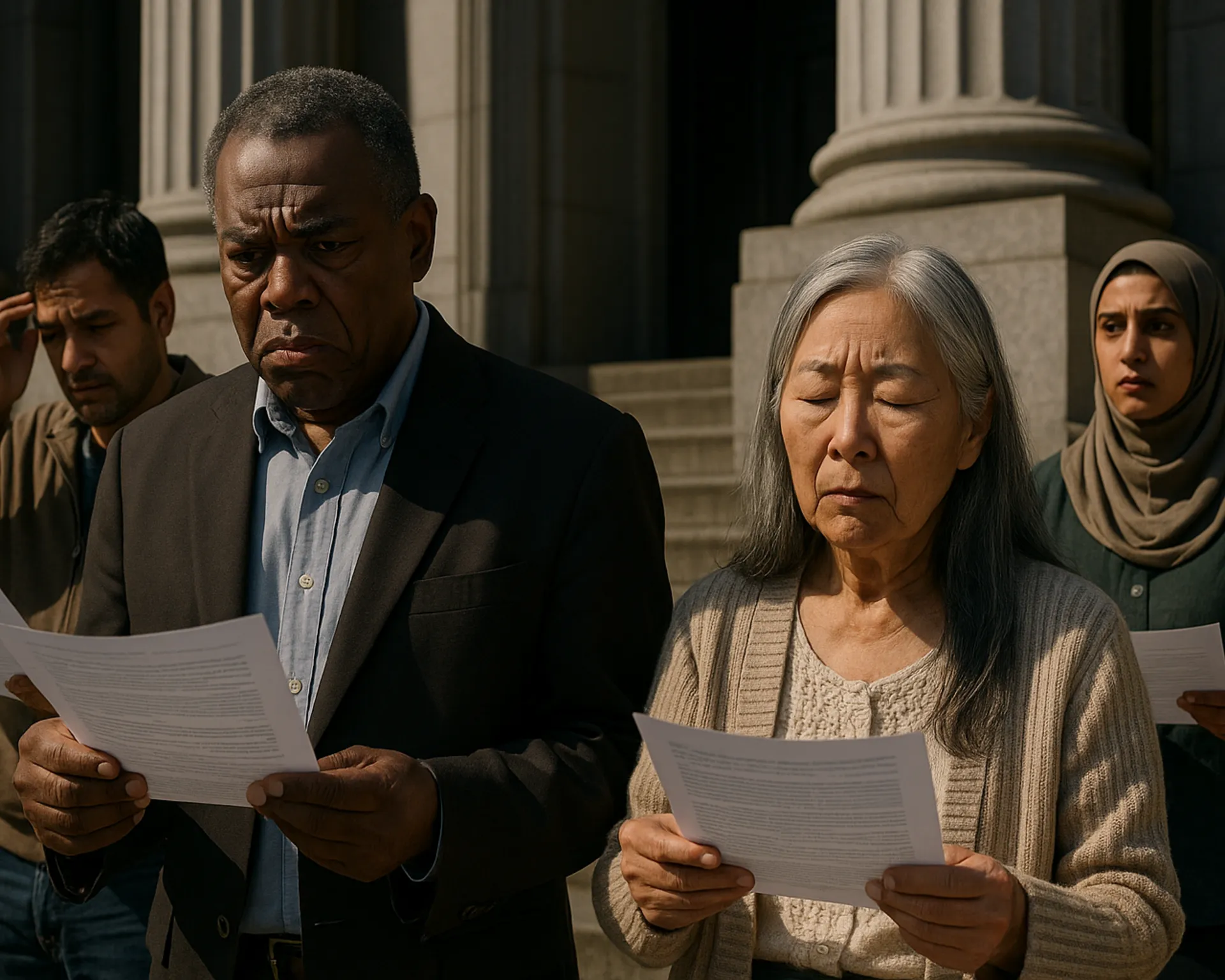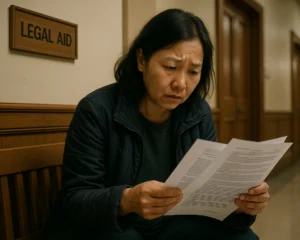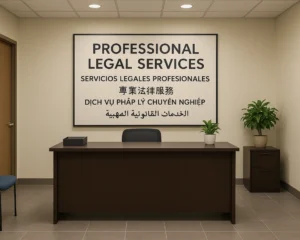Justice should not depend on which language you speak. Yet across America, millions of people face a stark reality — their inability to understand or communicate in English creates barriers that deny them access to fundamental legal rights and protections. This is not a peripheral issue affecting a small minority. It is a crisis at the heart of our justice system, one that undermines the principle that all people, regardless of the language they speak, deserve equal protection under the law.
The California Justice Gap Study revealed that millions of Californians lack access to legal services when they need them most. For individuals with limited English proficiency (LEP), this gap becomes a chasm. Language barriers compound every challenge in accessing justice — from understanding legal notices to navigating court procedures, from communicating with attorneys to comprehending the rights that should protect them. When the law speaks only English, it speaks only to some.
The consequences extend far beyond inconvenience. Language barriers can mean the difference between keeping custody of your children or losing them, between defending yourself against criminal charges or accepting a plea you don’t understand, between securing housing or facing homelessness, between obtaining protection from domestic violence or remaining in danger. These are not hypothetical scenarios. They are the daily reality for LEP individuals attempting to navigate a legal system that was not designed with them in mind.
The Scope of Language Barriers in the Justice System
According to the U.S. Census Bureau, over 25 million people in the United States speak English “less than very well.” These individuals represent hundreds of language communities — Spanish speakers certainly constitute the largest group, but also speakers of Chinese, Vietnamese, Tagalog, Arabic, Korean, Russian, Haitian Creole, and countless other languages. Each of these communities faces unique challenges in accessing legal services, and the scarcity of resources varies dramatically depending on language pair and geographic location.
The National Center for State Courts (NCSC) has identified language access as a critical component of the access to justice crisis. Their 2025 Trends report highlights how courts are deploying AI and other technological solutions to close access-to-justice gaps, recognizing that traditional approaches have failed to meet the scale of need. Yet technology alone cannot solve a problem rooted in systemic inequities and insufficient investment in language services.
The shortage of qualified legal translators and interpreters creates bottlenecks throughout the justice system. Court hearings must be postponed when interpreters are unavailable. Legal aid organizations turn away clients they cannot serve in their language. Private attorneys decline cases because they lack language capacity. Immigration proceedings — where language barriers are particularly acute — move forward with inadequate interpretation, potentially affecting life-altering decisions about deportation, asylum, and family separation.
How Language Barriers Deny Fundamental Rights
The right to understand legal proceedings is not a courtesy. It is a constitutional requirement rooted in due process protections. Yet the practical reality often falls short of this ideal. Consider the individual who receives an eviction notice in English but cannot read it, missing the deadline to respond and losing their housing as a result. Or the parent who signs away custody rights because the document was never translated and they trusted the person who told them what it said. Or the defendant who pleads guilty to a crime they didn’t commit because they couldn’t understand the charges, the evidence, or the consequences of their plea.
These scenarios repeat themselves daily across America. Language barriers create information asymmetries that fundamentally undermine justice. When one party to a legal proceeding cannot understand what is happening, cannot communicate their perspective, cannot read the documents that determine their fate, the adversarial system breaks down. The scales of justice tip not based on the merits of the case but based on who can speak and understand English.
Civil Legal Matters and Language Access
Civil legal matters — housing, family law, consumer protection, employment, public benefits — affect the daily lives and wellbeing of millions. Yet civil legal aid is chronically underfunded, and language access within civil legal aid is even more scarce. The Legal Services Corporation estimates that low-income Americans receive inadequate or no legal help for 92% of their civil legal problems. For LEP individuals, that percentage is even higher.
Family law cases present particularly acute language access challenges. Custody disputes, divorce proceedings, domestic violence protection orders — these matters involve complex legal standards, emotional testimony, and life-altering consequences. When parents cannot understand the proceedings or communicate effectively with their attorneys, the court’s ability to make decisions in the best interest of children is compromised. When domestic violence survivors cannot explain their situations in their own language, they may be denied the protection orders that could save their lives.
Housing cases move quickly, often with minimal notice. An LEP tenant who cannot read an eviction notice, cannot understand their rights, and cannot find an attorney who speaks their language faces an uphill battle to avoid homelessness. Consumer protection cases involving predatory lending, fraud, or unfair business practices often target LEP communities precisely because language barriers make it harder for victims to seek redress.
Criminal Justice and Language Rights
The Sixth Amendment guarantees the right to understand criminal charges and proceedings. Courts generally provide interpreters in criminal cases, recognizing the constitutional imperative. Yet even in criminal matters, language access is often inadequate. Interpretation quality varies widely. Not all languages have sufficient numbers of qualified interpreters. Interpretation may be provided in court but not during attorney-client meetings, plea negotiations, or interactions with probation officers.
The consequences of inadequate language access in criminal cases are severe. Innocent people may plead guilty because they don’t understand the charges or the process. Defendants may be unable to assist in their own defense because they cannot communicate effectively with their attorneys. Witnesses may be unable to provide testimony because interpretation is unavailable or inadequate. Victims of crime may be unable to participate in proceedings or access victim services.
Systemic Barriers Beyond Individual Cases
Language barriers affect not only individual cases but also systemic access to justice. Legal information — about rights, resources, procedures, and protections — is overwhelmingly available only in English. Court websites, legal aid organization materials, know-your-rights guides, and self-help resources rarely exist in multiple languages. Even when translations are available, they are often incomplete, outdated, or written in formal legal language that is difficult to understand even for native speakers.
This information gap means that LEP individuals often don’t know they have legal rights or remedies. They may not know that legal aid exists, that they can request an interpreter, that they have defenses to eviction or debt collection, that they can seek protection from abuse. Lack of information becomes a barrier to accessing the very systems designed to provide justice and protection.
Geographic disparities compound language access challenges. Urban areas with large immigrant populations may have more language resources, though still insufficient to meet demand. Rural areas often have virtually no language access services. An LEP individual in a small town may have no option for legal representation in their language, no interpreter available at the local courthouse, no translated materials explaining their rights.
The Economic Dimension of Language Barriers
Language barriers intersect with economic barriers to create compounding disadvantages. LEP individuals are disproportionately low-income, making them eligible for civil legal aid but unable to afford private attorneys. Yet legal aid organizations, already stretched thin, often lack the language capacity to serve LEP clients. This creates a cruel irony — the people most in need of free legal services are least able to access them.
Private translation and interpretation services are expensive. An LEP individual who needs documents translated or wants to bring an interpreter to a legal consultation faces costs that may be prohibitive. While courts generally provide interpreters for hearings, they rarely cover translation of documents or interpretation for attorney-client meetings outside of criminal cases. The financial burden of accessing justice in a language other than English falls on those least able to bear it.
Solutions and the Path Forward
Addressing the language access crisis requires multifaceted solutions at every level of the justice system. Technology offers part of the answer — AI-powered translation tools, remote interpretation services, multilingual legal information platforms. As discussed in our article on AI-powered translation in courts, these technologies can extend the reach of limited human resources when implemented thoughtfully with appropriate safeguards.
Yet technology is not sufficient. We need increased investment in training and certifying legal interpreters and translators, particularly for less common language pairs. We need funding for legal aid organizations to hire multilingual staff and contract with language service providers. We need courts to develop comprehensive language access plans that go beyond minimal compliance to genuine accessibility.
Plain language initiatives can help make legal information more accessible to everyone, including LEP individuals. When legal documents and court forms are written in clear, simple language, they are easier to translate accurately and easier for LEP individuals to understand even with limited English. The Plain Language Action and Information Network provides resources for making government communications more accessible.
Community-based organizations play a vital role in bridging language gaps. Organizations that serve immigrant communities often provide language access services, know-your-rights education, and connections to legal resources. Supporting and funding these organizations is essential to reaching LEP individuals who may not know how to access the formal justice system.
Policy and Legal Frameworks
Federal law provides some protections for language access. Title VI of the Civil Rights Act prohibits discrimination based on national origin, which courts have interpreted to require meaningful language access in programs receiving federal funding. The Limited English Proficiency (LEP) federal website provides guidance for agencies on meeting their obligations. However, enforcement is inconsistent, and many gaps remain.
New York City’s Language Access Fund, launched in January 2025, represents an innovative approach to addressing language barriers. The fund provides resources specifically for language access services, recognizing that meaningful access to justice requires dedicated investment. Other jurisdictions should consider similar initiatives, tailored to their local language demographics and needs.
Professional standards for legal interpreters and translators need strengthening. The American Translators Association and the National Association of Judiciary Interpreters and Translators provide certification and training, but more investment is needed to build the pipeline of qualified professionals. Law schools should incorporate training on working with interpreters and serving LEP clients. Bar associations should provide continuing legal education on language access obligations and best practices.
Justice That Speaks Every Language
The access to justice crisis cannot be solved without addressing language barriers. Every reform aimed at expanding access to legal services — increased legal aid funding, court simplification initiatives, pro bono programs, self-help resources — must include language access as a central component. Otherwise, these reforms will continue to leave LEP individuals behind.
Language access is not a special accommodation or a burden on the system. It is a fundamental requirement of justice. When courts, legal aid organizations, and attorneys fail to provide meaningful language access, they deny due process and equal protection. They create a two-tiered justice system where rights depend on which language you speak.
The solutions exist. Technology can help extend limited resources. Investment in training can build the interpreter and translator workforce. Plain language can make legal information more accessible. Community partnerships can reach LEP individuals where they are. Policy reforms can create frameworks and funding for comprehensive language access.
What is required is the will to prioritize language access as essential to justice, not optional or secondary. Every person who enters the justice system — as a party to a case, as a witness, as a victim, as a defendant — deserves to understand what is happening and to be understood. Every person deserves legal information in a language they can comprehend. Every person deserves representation that can communicate effectively with them.
Justice that speaks only English is not justice at all. It is a system that serves some while excluding others, that protects those who can navigate it while leaving others vulnerable. True justice speaks every language. It meets people where they are, communicates in ways they can understand, and ensures that legal rights and protections extend to everyone regardless of the language they speak. Until we achieve that vision, the access to justice crisis will continue to deny millions of people the fundamental promise of equal justice under law.




